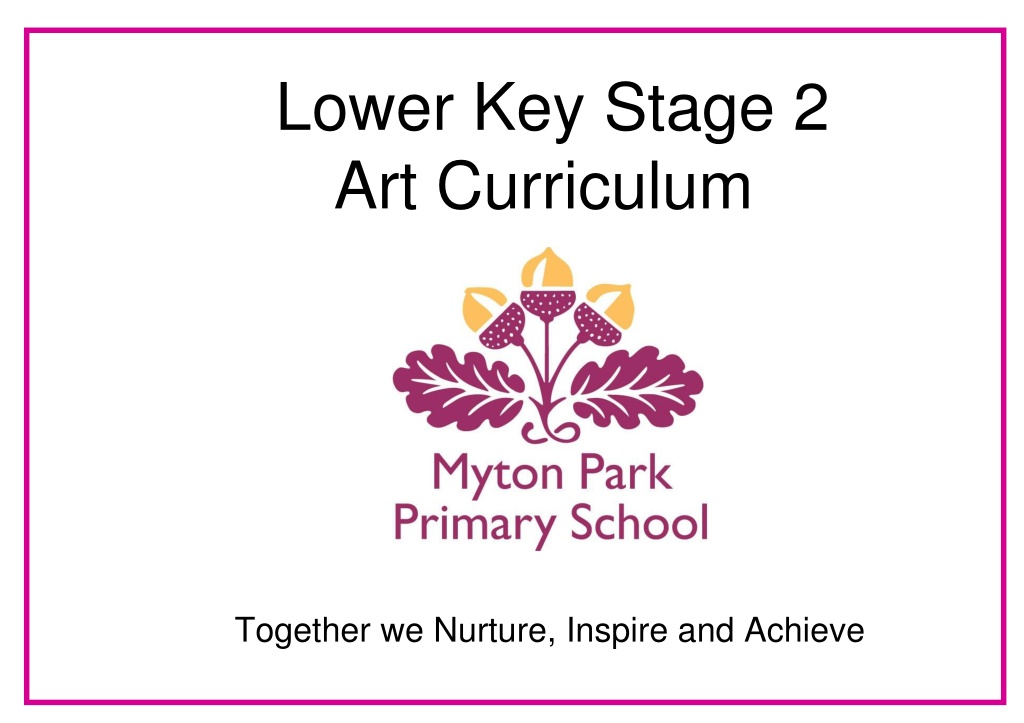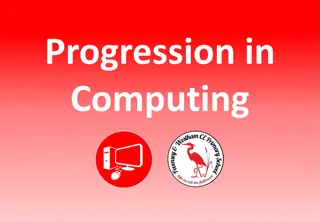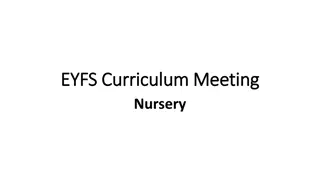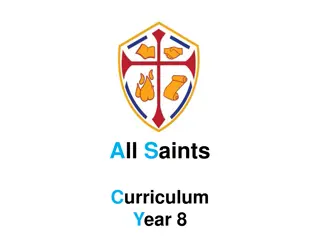Exploring the Lower Key Stage 2 Art Curriculum
Delve into the Lower Key Stage 2 Art Curriculum that focuses on nurturing, inspiring, and achieving creativity in students. The curriculum covers various art topics organized around historical themes, such as the Renaissance, abstract art, cityscape art, symbolism, and more. Students learn about famous artists, techniques, and artistic styles, encouraging them to engage with different art forms and deepen their understanding of art history.
Download Presentation

Please find below an Image/Link to download the presentation.
The content on the website is provided AS IS for your information and personal use only. It may not be sold, licensed, or shared on other websites without obtaining consent from the author. Download presentation by click this link. If you encounter any issues during the download, it is possible that the publisher has removed the file from their server.
E N D
Presentation Transcript
Lower Key Stage 2 Art Curriculum Together we Nurture, Inspire and Achieve
Art topics overview Art topics are organised and referenced around a historical schema. Each topic either introduces an aspect of the schema or references previous instances of it. Below is an overview of the topics we teach and which aspects of the schema it strengthens: ts * * * * The Renaissance * * * * Leonardo da Vinci * * * * * All work and no play * * * * L S Lowry * * * * Abstract art * * * * Wassily Kadinsky * * * * Cityscape art * * * * Camille Pissarro * * * * Symbolism * * * * Edvard Munch * * * Journey into space * * * * Robert McCall * * * * Myths and legends * * * * Peter Paul Rubens * * * impressionism * * * * Pierre August Renoir
The Renaissance This table shows the knowledge that will be taught in each lesson Name four famous Italian Renaissance artists. Give examples of famous Renaissance artists who were not born in Italy. What type of art was Albrecht D rer particularly known for. Where and when did the Renaissance period start? Why was this period considered to be a rebirth? Describe the term humanism and its significance during this period How did Renaissance artists create the effect of their art being lifelike? What was typical about how people were painted during this period? Explain the terms depth and perspective Explain how an artist would create a fresco painting. Why do you think Renaissance artists liked to paint in this way? Give an example of a fresco painting that was created during the Renaissance period and can still be seen toda Year 3 Explain the link between the wealth of Italy in the 14th century and the start of the Renaissance period. Choose a famous Italian Renaissance painter to research. Give examples of why their art is highly respected and led them to become well known. Investigate the style of painting or sculpture of each of the four suggested Italian Renaissance artists. In which ways are they typical of the Renaissance period? Summarisethe concept of realism and suggest reasons why this was important during the Renaissance period. Imagine you are a Renaissance artist. Create a piece of art using a realist style. What are the connections between Rosa Bonheur s animal paintings and the realist style of Renaissance painters What do you think is meant when people say that Renaissance art can transport the viewer directly into the scene? Create a piece of art to try and show depth in the person or object you are depicting. Explain how you have tried to make the person or object look 3D and not flat. Explore the technique of painting onto a wet surface, like a fresco painting. Discuss with a friend how successful this was and compare it to painting on a dry surface. Research the fresco painting in the Sistine Chapel. Create a summary report to share some of the key features. Year 4
The Renaissance Leonardo da Vinci This table shows the knowledge that will be taught in each lesson What technique did da Vinci use to sketch a body? Why did da Vinci throw his silhouettes from the tops of buildings? Copy da Vinci s technique to make your own sketch of the human body. Give examples of how da Vinci experimented with paint. How did da Vinci make his own oil paints? Explain what is meant by tempera What is the sfumatotechnique which da Vinci used to paint the Mona Lisa? Copy this technique to create your own painting which avoids the use of sharp outlines. How did da Vinci make the Mona Lisa appear pale? What inspired da Vinci as a young boy? Why did da Vinci keep hundreds of notebooks? List some of the things that da Vinci became very talented at Year 1 Draw two human bodies: one copying da Vinci s technique, the other without the initial sketch outline. Suggest reasons why da Vinci may have found his technique effective? Develop the way you draw a human body s movement by using da Vinci s technique of throwing silhouettes from a high place. Evaluate how useful you found this technique. Imagine you are da Vinci and explain how keeping so many sketchbooks helped you to become a talented artist Do you agree with people who use the term Renaissance man to describe someone who is very talented at many things, like da Vinci? Justify your answer with specific examples. Research further the famous works of da Vinci. Compile a list of the media and materials that he was talented at using Propose reasons why an artist, like da Vinci, might choose to use different materials based on what they have been asked to paint Experiment with the sfumato technique to try and create a similar effect of mystery or sombrenessas seen in da Vinci s Mona Lisa Do you agree that da Vinci s use of the sfumatotechnique would not work well when creating abstract art like that of WassilyKandinsky? Year 2
All work and no play This table shows the knowledge that will be taught in each lesson What is meant by genre painting ? Give two examples of a period in history when genre painting was popular. List some of the features you might see in a genre painting What does Ford Madox Brown s painting Work show? Describe some of the characters in this painting. Why is this painting seen as being typical of Madox Brown s style? Name some artists who have produced famous art that shows people at work. How do these artists help people discover more about social history? Which type of people were 17th-century Dutch artists more likely to depict working? Give two examples of how an artist might use body language to show emotion. How might a person be feeling if they are shown with slumped shoulders or a lowered head? Copy artists like MadoxBrown by using body language to show the different emotions of people in a painting. Year 1 Explain why the term genre painting could be confusing. Summarisethe reasons why genre paintings often show people who are not often painted in other styles of art. What is the connection between typical scenes in genre paintings of the Victorian period and cities such as London and Paris that were growing rapidly at the time? Imagine you are one of the characters in MadoxBrown s Work painting. Summarise what you are doing and how you are feeling True or false? Artists always create their work at the actual scene so that they can capture the precise details. Compare paintings by artists showing people working in Victorian Britain. Which aspects of the scenes are similar? Research the work of British artist Joseph Wright. Compare how he showed people at work with paintings by other artists you have studied. Organise in a table examples of how artists draw different gestures and expressions. Link these with the emotions that are being shown. Do you agree that the style used by Hans Holbein the Younger in his royal portraits would not be effective if used to show people at work? Year 2
All work and no play L. S. Lowry This table shows the knowledge that will be taught in each lesson How did the place where L.S. Lowry lived influence his artwork? Describe how Lowry would quickly draw his initial sketches. Give examples of typical features of Lowry s paintings Why is Lowry s colourpalette described as restricted? List the five coloursused by Lowry. Choose one of Lowry s colours and explain how it may have been used. Describe the typical features of Lowry s matchstick people. Why did he draw many of his matchstick people leaning forward with their heads down? What was the effect of Lowry filling a painting with so many matchstick people? What technique did Lowry often use to create tones? How did he then vary the depths of the tones? Copy Lowry s techniques to create your own tones within a piece of art. Year 1 Explain how Lowry s paintings provide evidence of how his art was influenced by the industrial area in which he lived. What is the connection between Lowry and Leonardo da Vinci in the way they began the process of creating a piece of art? Using five similar coloursto Lowry s palette, create your own original painting showing workers in an industrial town. Do you agree with critics who might say that Lowry s colour choices were dull and not very interesting to look at? Replicate the use of matchstick people and experiment with body shapes to give the effect of people looking tired or determined. Research the paintings of Lowry and compile a summary report detailing the different ways he used matchstick people to create different effects Explore Lowry s technique of creating a white background and then sketching outlines in pencil or charcoal In which ways do the techniques used by Lowry to create tones compare to, or differ from, the techniques used by other artists you have studied? Year 2
Abstract art This table shows the knowledge that will be taught in each lesson List some of the common features of abstract art. When and where did abstract art become popular? What do abstract artists often paint when using the colour field style? Name at least two American abstract artists. What type of artworks did British artist Henry Moore produce? Who painted Electric Prisms in 1914? Why do abstract artists often use strong contrasting colours? What is meant by the word chromatic ? Give a definition of the term transparent . Name the contrasts to the following terms: dark, cool, transparent, chromatic. What technique did Jackson Pollock use instead of brushstrokes? Why do some abstract artists use the technique of action painting? Copy Jackson Pollock s painting technique to create a piece of abstract art Year 1 Explain why an abstract artist is unlikely to paint a real object or living thing. Summarisethe key abstract features within Sonia Delaunay s painting Electric Prisms. Why do you think some people describe abstract art as having been produced in a random way? Justify your answer with specific examples. Compare and contrast Henry Moore s abstract sculptures with the realist sculptures created during the Renaissance period. Find evidence of similar abstract features used by American abstract artists. Investigate the work of a modern-day abstract artist and compare their work with that of some of the first American abstract artists. Explain why the coloursused by L.S. Lowry would not have been as effective if used to create abstract art. Explore the impact of the use of chromatic and grey contrasts when creating a piece of abstract art. Always, sometimes, never? Strong contrasting coloursare effective for all styles and types of art. Explain why action painting is an effective technique for an artist who wants to show emotion in their art. Why do you think that art critics have very different opinions of the work of artists like Jackson Pollock who used techniques other than brushstrokes? Year 2
Abstract art Wassily Kandinsky This table shows the knowledge that will be taught in each lesson What did Kandinsky encourage artists to do instead of following a trend? How did Kandinsky believe artists can treat art like music? Why did Kandinsky think it was important to be original? Which three shapes did Kandinsky regularly use to convey emotions? Which shape did Kandinsky use to show anger and aggression? Why did Kandinsky often use square shapes? List three materials that Kandinsky preferred to paint onto. Name at least three types of paint that Kandinsky used to create his abstract art. Describe what is different about gouache paint. What are the main features of Kandinsky s painting Yellow, Red, Blue? What is meant by the term spectrum ? Copy Kandinsky s use of yellow, red and blue and different shapes to create an abstract painting. Year 1 Explain what Kandinsky meant when he said that colour should be used as a window into the human soul . Explore ways of sketching and colouringshapes using repetition to create amplification. Explain and justify how the five processes described in Kandinsky s essays show that he believed that art was about freedom. Choose a set of different shapes to show different emotions. Explain your choices. Find evidence of how other abstract artists have used shapes to convey emotion. Do you agree that using shapes to show a range of emotions, as Kandinsky did, is just as effective as showing facial expressions and gestures when drawing and painting people? Compare and contrast the effect of painting on wood, canvas and glass. Explore the impact of using gouache paint. Experiment with different amounts of glue to create different effects. Experiment with Megan Coyle s collage style to create a piece of abstract art using shapes and vivid coloursas Kandinsky did. Evaluate the finished piece by comparing it to the paintings of Kandinsky. Explain to a friend what is meant by complementary secondary hues and give specific examples. Present a piece of writing to demonstrate how, when looking at Yellow, Red, Blue, the eye is taken on a journey of straight lines, curves and waves. Year 2
Cityscape art This table shows the knowledge that will be taught in each lesson List some famous artists well known for creating cityscapes. Who was Canaletto? How does Richard Estes create his cityscape art? Why did cityscape paintings become less popular in the 20th century? Describe the style of photorealism. How does a hyperrealist painting differ from a photorealist painting? What first inspired Yvonne Jacquette to create her cityscapes? How did flying more regularly help Jacquette to be a better artist? Imagine you are flying in a plane. Copy Jacquette s style by drawing your own imaginary aerial landscape What effect does the precise style of Richard Estes have in his photorealist paintings? Explain what you would not be able to see in an inanimate painting. Why does Estes deliberately create the effect of an inanimate picture? Year 1 Suggest reasons why there are fewer examples of artists inspired to create cityscape art the further you go back in history. Research the cityscape art of a famous artist who lived before the 20th century. Compile a short report to detail the key features of one of the first examples of cityscape art, The Baths of Trajan, created during the time of Ancient Rome. Explain the differences between a photorealist and hyperrealist picture. Use a photograph of part of the outside of the school building to create a piece of art that is as close to the style of photorealism as you can make it. Investigate the work of Richard Estes or another photorealist artist to discover how they have used digital media to develop their style. Research how Yvonne Jacquette has painted night- time cityscapes of New York City. Which features are similar in these pieces of art? What are the connections between Yvonne Jacquette s night-time cityscape art and the work of artists who have depicted space who you have previously studied? Summarisethe ways in which the photorealist painting Columbus Circle Looking North by Richard Estes have a clean and realistic effect. Do you agree with the view of Richard Estes that cameras can distort vision? Year 2
Cityscape art Camille Pissarro This table shows the knowledge that will be taught in each lesson Describe the key features of Camille Pissarro s painting The Boulevard Montmartre at Night. What inspired Pissarro to paint this scene? Why did some art critics believe that paintings like this by Pissarro were vulgar? How does Pissarro paint the people to create the effect of busy crowds in this painting? Describe how Pissarro applied the paint to add to this effect. Copy Pissarro s style of applying paint using dashes and smears to create an effect of busy crowds in a city scene. What did Pissarro like to depict in his cityscapes? How did Pissarro show dynamic movement through his brushstroke technique? Copy the brushstroke technique of Pissarro to show movement in your cityscape art. Give examples of the different types of artificial light in this painting. How did Pissarro paint the different types of artificial light? Describe how Pissarro has painted the sky to make the contrasts more powerful. Year 1 Summarisehow Pissarro has shown perspective in his painting The Boulevard Montmartre at Night. Develop the use of perspective by sketching a street scene outside your school. Do you agree with art critics who describe art that shows everything the artist can see, even if it may be rubbish on a street, as vulgar? Suggest at least three different ways in which Pissarro has been able to create the effect of a busy city in this painting. What are the connections between this painting by Pissarro and the style of L.S. Lowry in terms of how the artists paint people? Compare and contrast Pissarro s techniques used to create a busy cityscape with the techniques used by Richard Estes to create his inanimate cityscapes. True or false? Using the brushstroke technique of Pissarro is the only way to depict movement in a piece of art. Experiment with colourto show the contrast between a dark sky and the artificial lights within a cityscape. Investigate how Pissarro s use of contrasting coloursis quite different from the way abstract artists use contrasting colours. Year 2
Symbolism This table shows the knowledge that will be taught in each lesson In which century did Symbolist artists become famous? Name three different French Symbolist artists. What were the two ways in which Jean Delville used Symbolism? Describe the features of Odilon Redon s The Crying Spider. What media and materials did Redon use to create his noirs? Why might Redon have used the spider s body as a symbol? Why is the colourblack often used in Symbolism? What reasons did Redon give for using the colourblack? Sketch a drawing copying the symbolist style, using charcoal or a black crayon/pencil to depict something sad or a nightmare. Give examples of two things that could be used to symbolisewealth. Why might the condition of an object change the idea it is symbolising? Choose your own objects to include in a Symbolist picture and explain to a friend why you have chosen them Year 1 Research the work of two Symbolist artists to compare how they have used symbols in their artwork. Do you agree that Symbolism in art is more effective when the artist deliberately makes the meaning of their work obscure? Explain the possible symbolic link between Redon s crying human face and the spider s body. Investigate the creatures and symbols used by Redon in some of his other noirs. Compare and contrast how the colourblack has been used in other styles of art you have studied. Imagine you are OdilonRedon being interviewed. Explain what you mean by the link between using the colour black and the viewer having to think more about the piece of art. Organise a table to summarise the use of common symbols and their meanings. Include reasons why you think the objects represent these ideas. What are the connections between Symbolism and the creations of the abstract artists you have studied? Year 2
Symbolism Edvard Munch This table shows the knowledge that will be taught in each lesson How did Edvard Munch use his personal life to influence the themes of his art? Give an example of how Munch sequenced the themes of his art to take people on a journey of emotions. Why did Munch think his personal tragedies and illnesses were necessary to him? What do many people think The Scream symbolises? Describe what you can see in the picture. What personal experience inspired Munch to create this example of Symbolist art? Who inspired Munch when he was a young artist? How did he copy Paul Gauguin s techniques? How did Munch later develop this into his own style? Copy the brushstroke technique and use of flowing lines developed by Gauguin and Munch in your own version of The Scream Give examples of the media and materials that Munch experimented with. How was Munch influenced by a Japanese tradition? List the media and materials Munch used to create his five different versions of The Scream Year 1 Find out more about some of the paintings of Edvard Munch to discover the themes that he repeated in his work. Do you agree with Munch when he said that without his personal experiences his art would be destroyed? Compare and contrast the five different versions of The Scream that Munch created. Which version do you prefer and why? Create your own interpretation of The Scream using a personal experience of being scared. Justify your use of colourand style when discussing your work with a friend. Experiment with the use of flowing lines to symbolise the following emotions: fear, happiness, bravery, anger, despair. What are the similarities and differences between the flowing lines of Munch and the shapes used by Kandinsky to symbolise emotion? Explore and discover the effects of overlaying different media and materials in your own piece of art. Investigate the Japanese tradition of woodcutting and how this influenced the work of Edvard Munch. Year 2
A journey into space This table shows the knowledge that will be taught in each lesson What might a Space or Astronomical artist depict in their art? Why do some people believe that Space artists are important? Why was the work of artist Lucien Rudaux often praised? Who was Chesley Bonestell? In which century did Space art begin to flourish? How are Space artists different from artists who use science fiction and fantasy as their inspiration? What do Space artists find difficult when producing their art? Why is David A. Hardy well known for his art? What inspired Hardy to become a space artist? How did doing lots of research help Hardy to be a successful Space artist? Copy Hardy s source of inspiration by looking at natural objects in the night sky and painting an accurate representation of them. Year 1 Summarisethe importance of Space artists creating their artwork with links to scientific discovery. Compare the lunar landscapes painted by Lucien Rudaux with photographs of the moon s real landscape. Give reasons why people say his work is accurate. True or false? Space art has become more realistic since the invention of the telescope in the 17th century. Research the work of Chesley Bonestell to discover why people were disappointed with the real surface of the moon compared to his paintings Compare and contrast the work of Space artists and artists depicting science fiction and fantasy. Create your own piece of Space art through representing the features of space realistically. Sketch your own space drawing in the style of fantasy/science fiction. Explain the key differences between the two pieces of art. Always, sometimes, never? The artwork produced by Space artists is more important than the art created by people inspired by fantasy and science fiction. Do you agree with art critics who believe that successful Space art is both original and imaginative but also stays close to scientific facts and reality? Find out more about the work of David A. Hardy in order to understand how his early interest in space influenced his work. SummariseDavid A. Hardy s opinions about how to be a successful Space artist. Investigate the work of other Space artists. What are the connections between taking time to do research, as recommended by David A. Hardy, and the success of the Space artist? Carry out your own research into what another planet looks like and create your own accurate representation through a piece of art. Year 2
A journey into space Robert McCall This table shows the knowledge that will be taught in each lesson What makes Robert McCall s artwork particularly unusual? Why do you think McCall s mural The Space Mural A Cosmic View took him so long to create? Describe some of the features of this famous mural. How did McCall s art style begin to change in the 1960s? What did he try and show in these paintings which represented his beliefs about the future? Copy McCall s ideas and beliefs to produce your own Space art showing the future. Why do many people praise and appreciate McCall s art? How does McCall s art make many people feel? Describe how McCall s mural makes you feel about space exploration in the past and in the future How did McCall use colour? Why did he use bright, vivid coloursin his paintings? Describe how he used contrasting colours. Year 1 Summarisethe ways in which Robert McCall depicts the past, present and the future in his famous mural The Space Mural A Cosmic Vie. Imagine you were creating your own space mural. Develop your own ideas to explain how you would represent the past, present and future. Compare and contrast an example of McCall s realistic space art, created when working for NASA, with one of his pieces of conceptual art created for the entertainment industry. Investigate the conceptual art of Robert McCall to research how he depicted wonder and excitement about the future. Explain why you think McCall shows the rays of the sun creating light in his famous space mural. Create your own Space art to make people feel optimistic about the future. Explain why you have chosen the features in your art. Do you agree that Space art should always be created to provide hope and optimism. Summarisethe reasons why McCall prefers to use bright, vivid coloursrather than too much black when creating Space art. What similarities and differences can you find between Robert McCall s use of contrasting colour and that of abstract artists like Wassily Kandinsky? Year 2
Myths and legends This table shows the knowledge that will be taught in each lesson Name some examples of artists who have been inspired by myths and legends. What sorts of things might these artists have painted when inspired by myths, legends or folk stories? Who is Joan Jonas? When and where did Pre- Raphaelite artists become well known? What style of art did they not like? Describe a typical Pre- Raphaelite painting. What inspires Joan Jonas to create art? Give examples of the media and materials she used to create her famous piece of work The Juniper Tree. Copy the style of Jonas and the types of media and materials she used to produce your own piece of visual art to depict a well-known fairy tale. Name some typical characters in fairy tales that you could try to depict in a painting. Copy the suggested techniques to create your own fingerprint fairy-tale character. Add extra details for your character and explain why you have included them. Year 1 Compare and contrast the style of Renaissance artists and that of the Pre-Raphaelites. Summarisethe key differences between the two styles. Investigate the examples of fairy-tale paintings by Burne- Jones and the portrayal of Greek myths by Rossetti. Do you agree that the styles are similar? Find out more about the story The Juniper Tree and discuss with a friend the connections with the media and materials used by Jonas in her visual portrayal. Do you agree with art critics who describe Joan Jonas as a pioneer and a hero to younger artists? Explain the reasons why the techniques suggested might be effective for making a fingerprint fairy-tale character? What connections can you make between the techniques suggested and the artwork produced by L.S. Lowry? Research the work of Alessandro Botticelli to find out what kinds of myths or legends he painted. Create a summary report to show how the suggested artists, and others you may have researched, have been inspired by either myths, legends or folk stories. Year 2
Myths and legends Peter Paul Rubens This table shows the knowledge that will be taught in each lesson What did Rubens study during his eight years living in Italy? Which artists inspired him and influenced his style? Why is Rubens described as a prolific artist? What did Rubens use to produce his many drawings? Why did Rubens only need a small number of colourson his palette? Copy Rubens drawing technique by using three colouredchalks (black, white and red) to produce your own mythological scene. How did Rubens create lighting tones? How did Rubens direct the viewer s eye to the main feature of the painting? Use Rubens lighting effects by painting a dark background which lightens at the top or bottom Name some typical colours used by Rubens in his paintings. Why did Rubens like to fill his paintings with colour? How did Rubens make the main feature in his paintings more prominent? Year 1 Summarisethe importance of Rubens eight-year stay in Italy in relation to his later career as an artist. Do you agree with art critics who believe that Rubens combined ideas from both the Renaissance and Baroque periods in his art? Explain the reasons why Rubens produced so many sketches during his life. Create your own painting inspired by a myth or legend, using up to four different colours. Experiment with colourmixing so that your painting has a range of bright colours. Investigate the mythological paintings of Rubens to discover and prove the effectiveness of his colourmixing with a limited colourpalette. Imagine you are Rubens being interviewed. How would you explain why the background is sometimes lighter at the top of the picture but on other paintings it is lighter at the bottom? In which ways are Rubens methods to create the effect of lighting similar to or different from those of other artists you have studied? Experiment with applying more layers of colour to the main feature of your painting to make it more prominent. Always, sometimes, never? An artist should have many colouredpaints on his palette to create a painting full of bright colours. Year 2
Impressionism This table shows the knowledge that will be taught in each lesson Give two reasons why Alfred Sisley s painting The Bridge at S vres is typical of the Impressionist style. What did Sisley particularly like to paint? Describe the features of this painting. What effect particularly interested and concerned the Impressionist artists? How did they cope with rapidly changing weather and the passing of time? Copy the quick style of Impressionists to capture the current light and weather in an outdoor scene How is broken colourdifferent from mixing colourson a palette? Describe the terms hatching, cross-hatching and stippling. Practiseusing hatching and stippling to develop the broken colour effect. What is the impasto painting technique? Describe what using this technique might look like when the paint is dry. How did using short, thick brushstrokes help Impressionist painters? Year 1 Summarisethe reasons why Impressionism was very different from the art created in Europe before this period. Explore other paintings by Alfred Sisley. In which ways do they show typical features of Impressionist art? What is the connection between how Impressionists painted and their focus on capturing moments in time, including the light and weather? Do you agree with early critics of Impressionist artists who saw the lack of realistic detail as evidence that these artists were not as talented as others who were famous before them? Compare your use of the three methods to create the broken colour effect. Explain which one was most successful and give the reasons why. Always, sometimes, never? Mixing colourson a palette will lead to a more realistic painting than using broken colour. Explain how the impasto technique links to the way Impressionism attempts to capture movement and life. Justify why the impasto technique would not have been a good choice for Space artist Robert McCall to use. Year 2
Impressionism Pierre Auguste Renoir This table shows the knowledge that will be taught in each lesson Why were Renoir s teenage years painting porcelain significant? Describe how Renoir used a palette knife. How was Renoir meticulous? Describe the scene within Renoir s masterpiece Dance at Le Moulin de la Galette. Give examples of how this painting showed Renoir s talent as an artist. How does Renoir show the effect of light in this painting? What effect did Renoir s use of colourhelp to create? How did Renoir use colourto emphasisethe features at the foreground of his pictures? Copy Renoir s use of colourby producing your own picture showing a person or object prominent in the foreground. What did Renoir famously say that linked art with emotion? List examples of how Renoir painted his characters showing charm. Describe the emotions of the characters in his painting Dance at Le Moulin de la Galette Year 1 Summarisethe reasons why Renoir s use of media and materials was quite unusual for an Impressionist. In which ways do Renoir and other Impressionist painters, such as Claude Monet, compare and contrast when looking at their use of media and materials? Explain why the features of Renoir s masterpiece Dance at Le Moulin de la Galette provide one of the best examples of an Impressionist painting. Create a table of information to show the different examples of light in Renoir s masterpiece Dance at Le Moulin de la Galette and how he has created the effect with each example. Compare and contrast Renoir s use of colourin this painting with that of other Impressionist painters. Do you agree that the best way to emphasisea feature in the foreground of a piece of art is to use bold, complementary colours? Research other Impressionist paintings by Renoir to find out more about the charm of his characters. Imagine you were Renoir being interviewed to explain what he meant by his famous quote about art and emotion. How would you respond? Year 2























